A powerful, complex operations platform for field service businessves like lawn care, but with frustrating usability issues.
Verdict: 6.4/10
If you run a high-volume US lawn care, cleaning, or snow removal business, Service Autopilot is built for you. Its best features—from the granular job costing reports to its modules for handling fertilization packages or on-demand snow dispatch—are designed to solve the specific operational headaches of these industries. I was impressed by the professional estimating tools that help win new clients.
But this power comes at the cost of usability. The software feels clunky, with an interface split between 2 different versions. Plus, Service Autopilot completely ignores modern employee-facing tools like team chat. It’s frustratingly rigid for businesses outside its core industries or for anyone prioritizing a simple, user-friendly platform.
Key Features:
- Advanced scheduling and dispatching. A central dispatch board for managing recurring jobs, multi-day projects, and packages with AI-powered route optimization.
- Professional estimating tools. Build detailed proposals with complex pricing rules, complete with electronic signatures.
- Time tracking: A job timer that logs start, pause, resume, and stop for each visit—along with drive-time tracking.
- Two-way QuickBooks sync. An automatic sync with QuickBooks Online and Desktop that keeps most client, invoice, and payment data consistent across platforms.
- Job costing reports. Track exact profit margins on individual jobs with detailed breakdowns of labor, materials, and overhead costs.
- Industry-specific modules. Specialized features for lawn care, cleaning, snow removal, and pest control industries built into the same platform.
- Automations workflow. Create custom, trigger-based workflows to automate daily tasks like estimate follow-ups, past-due invoice reminders, and client communications.
Pros
- Highly customizable estimates
- In-depth job costing
- Powerful workflow automation
- Lots of personal onboarding help
Cons
- Users must switch between 2 versions
- Steep learning curve
- Manual payroll export
- No HR tools like team chat
Service Autopilot Pricing
Service Autopilot uses a single software platform that serves multiple industries, such as lawn care, cleaning, snow removal, and pest control—with industry-specific features and modules built into the same system.
There’s no free trial. Instead, the typical first step is to get a 1-hour personalized demo via Zoom with a sales representative.
Service Autopilot has 4 plans—Startup, Pro, Pro Plus, and Elite—which are differentiated by the number of users they support and the available software features:
| Startup | Pro | Pro Plus | Elite | |
| Monthly price | $49 | $199 | $499 | Custom |
| Full users | 1 | 1 | 1 | 2 |
| Mobile users | 1 | 2 | 5 | 8 |
| Scheduling | ✅ | ✅ | ✅ | ✅ |
| Invoicing | ✅ | ✅ | ✅ | ✅ |
| Expense tracking | ✅ | ✅ | ✅ | ✅ |
| Snow dispatch | ❌ | ✅ | ✅ | ✅ |
| Chemical tracking | ❌ | ✅ | ✅ | ✅ |
| Multi-day jobs | ❌ | ✅ | ✅ | ✅ |
| Route optimization | ❌ | ✅ | ✅ | ✅ |
| Dispatch calendar | ❌ | ✅ | ✅ | ✅ |
| Customized reporting | ❌ | ✅ | ✅ | ✅ |
| Automations | ❌ | ❌ | ✅ | ✅ |
| Multi-location management | ❌ | ❌ | ❌ | ✅ |
I feel the Startup plan is too basic for most businesses—you can’t, for instance, generate custom reports with this plan. The Pro Plus plan is better, and its big ticket item is the automation feature, which lets you, for example, set up a workflow that automatically sends follow-up emails to prospects who haven’t responded to estimates within 3 days.
The pricing plans are cleverly arranged to make the service seem cheaper than it really is at first glance. You must reach out for full pricing, and then things become clearer. There’s an initial setup fee of $92.50, and many other features have a monthly cost. For example, the QuickBooks integration costs $25/month, and route optimization costs $47/ month.
Every additional full user costs $29/month, with mobile-only users costing a more reasonable $19/month. As the base plans don’t support that many users by default, this per-user cost will often make up a significant portion of a company’s monthly Service Autopilot bill.
If you just need mobile-only licenses for your teams and stick with the Startup plan, Service Autopilot may be less costly than many comparable providers. But if you need full user licences and the features of the higher-tier plans—as I think most companies will—Service Autopilot will cost you more than its competitors.
| Team size | Service Autopilot (Startup) | LWM | Jobber | Connecteam (Basic) |
| View pricing | View pricing | View pricing | View pricing | |
| 10 Users | $201 | $317 | $249 | Free for life — All features and dashboards |
| 20 Users | $391 | $357 | $539 | $29 |
| 30 Users | $581 | Custom pricing | $684 | $29 |
| 50 Users | $961 | Custom pricing | $1264 | $39 |
| Read our full LWM review. | Read our full Jobber review. | Learn more about Connecteam. | ||
| * All prices show the monthly cost when billed annually as of July 2025.** Service AutoPilot Pricing assumes additional users are mobile-only. | ||||
Verdict: 7/10
Service Autopilot Usability and Interface
Getting up and running with the service can take time due to the user interface. It feels like over the past 16 years, additional features have been tacked onto the system based on customer requests. You need a few hours of introduction to its idiosyncrasies before you start to understand it.
Several multi-hour “Getting Started” videos are available, and some features—like chemical tracking and snow removal—can’t be activated at all until you’ve been through a training session with a Service Autopilot representative, so I think the company is well aware of the issue.
Perhaps the most significant challenge to usability is the platform’s split identity between its older “V2” (Classic) interface and the newer “V3” interface, which the company has been phasing in since 2020.
The V2 interface appears a bit dated and cluttered compared with V3. It relies on dense tables, small fonts, and text-heavy menus that can feel overwhelming. While V3 is a big step towards a more modern, visually appealing design, its incomplete implementation means users are constantly required to switch back to the older V2, making the overall look and feel fragmented.

This creates a disjointed user experience where navigation and logic aren’t consistent across the platform, forcing users to learn 2 different systems simultaneously.
Consequently, the software has a steep learning curve. This isn’t an intuitive, “pick-up-and-go” system. The sheer number of settings and the initial configuration required before the software is truly functional are substantial. The company’s own heavy emphasis on multiple, in-depth training options—from multi-day virtual courses to one-on-one sessions—shows users should expect to invest significant time in training before becoming proficient.
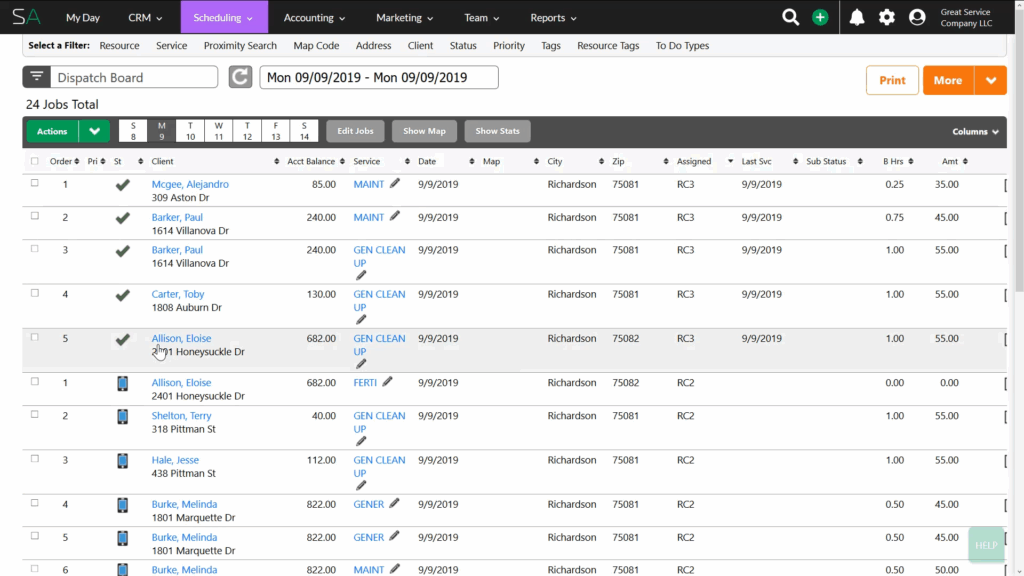
I also thoroughly searched all the provided documents for terms like “accessibility,” “screen reader,” or “impaired vision,” but my search was fruitless: Accessibility isn’t a documented priority.
Verdict: 6/10
Mobile app
Similar to how Service Autopilot has 2 web interfaces, it also has 2 mobile apps—the streamlined Team App and the more comprehensive Legacy App. Both apps are available on iOS and Android.
Most users need to download just one app based on their role. Field technicians typically use the Team App for basic daily tasks, while managers and administrators use the Legacy App, which has support for more complex functions like creating estimates and managing invoices.
The Team App covers the daily essentials. Workers can easily view their daily schedules, clock in for the day, and then start and stop individual jobs. They can also track drive time between locations and log non-billable time like breaks.
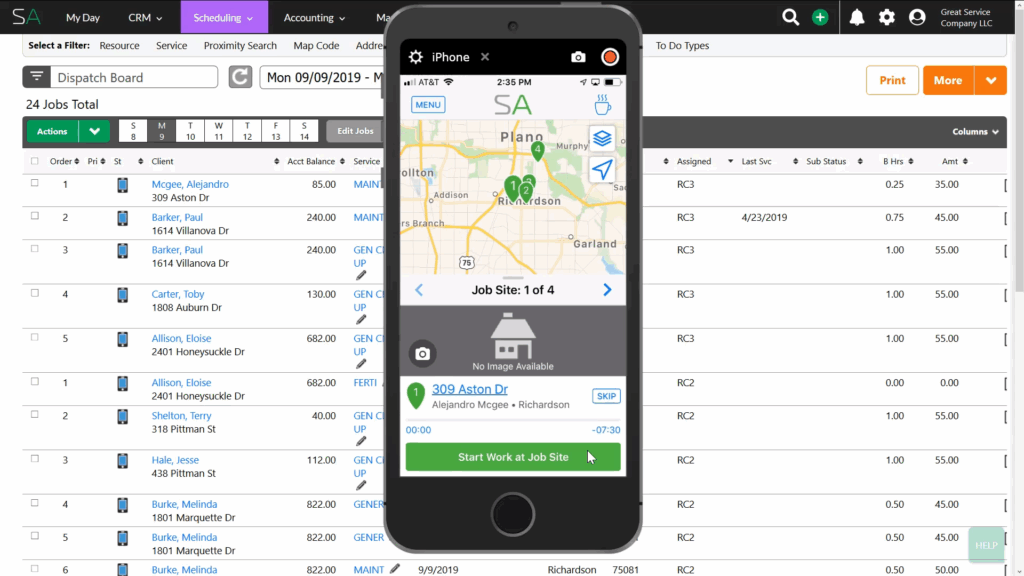
I really like how workers can be prompted to acknowledge specific job notes before starting work, which is perfect for giving them reminders—like gate codes they’ll need to access certain properties. Employees can also add their own comments and attach job-site photos directly from their phones.
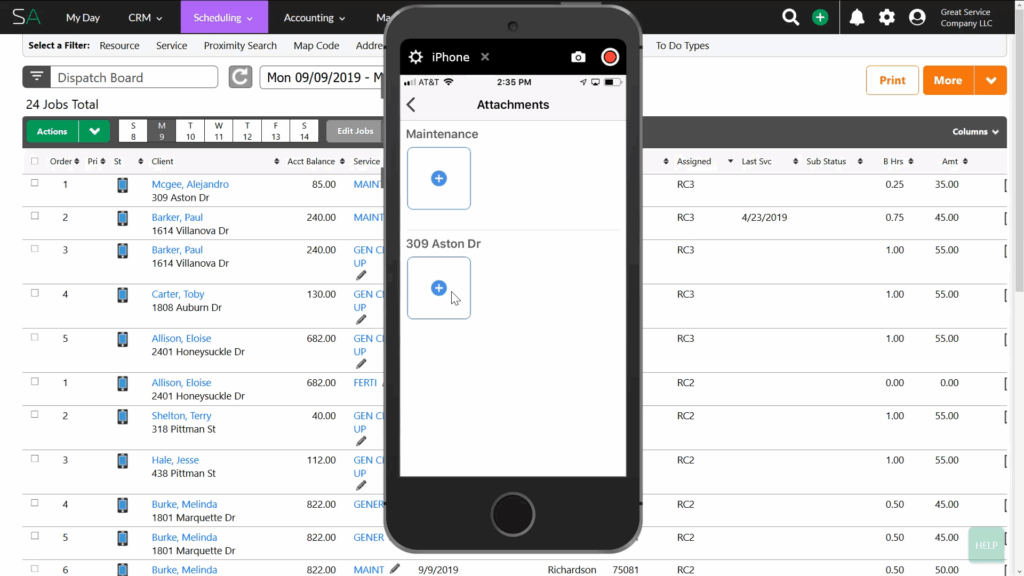
The apps have offline capability, so if a team is working somewhere with poor connectivity, they can save their updates locally and hit “Sync Everything” at the end of the day when back online.
Neither app is a full replacement for the desktop version. All the deep-level configuration—like setting up services, automations, or detailed user roles—must be done on the web. Reporting and analytics tools are also exclusive to the desktop site.
Another limitation: employees can’t request time off from the mobile app. They must use the desktop version for basic administrative needs, which feels outdated for mobile workforces.
| Menu Item | Admin | Employee | ||
| Website | Mobile App | Website | Mobile App | |
| Core features | ||||
| Timesheet | ✅ | ✅ | ✅ | ✅ |
| Time tracker | ✅ | ✅ | ✅ | ✅ |
| Time off approval | ✅ | ❌ | ✅ | ❌ |
| Calendar | ✅ | ✅ | ✅ | ✅ |
| Schedule | ✅ | ✅ | ✅ | ✅ |
| Time off | ✅ | ❌ | ✅ | ❌ |
| Analysis features | ||||
| Reports | ✅ | ❌ | ❌ | ❌ |
| View live team GPS | ✅ | ❌ | ❌ | ❌ |
| Management features | ||||
| Create/edit jobs | ✅ | ✅ | ❌ | ❌ |
| Create/send estimates | ✅ | ✅ | ❌ | ❌ |
| Create invoices | ✅ | ✅ | ❌ | ❌ |
| Take payments | ✅ | ✅ | ❌ | ❌ |
| Manage assignments | ✅ | ✅ | ❌ | ❌ |
Verdict: 6/10
Service Autopilot Core Functionalities
Scheduling and dispatching
Scheduling and dispatching is where Service Autopilot is the most fleshed out. I’m impressed by how detailed complex operational logistics can get in Service Autopilot. The system can manage everything from simple 1-time jobs to recurring package jobs for seasonal services—all through a central Dispatch Board.
Smart Maps, an add-on feature that costs $47/month, provides AI-powered route optimization that reduces drive time and fuel costs, going far beyond basic proximity routing. If your business has complex routes, this feature could make a meaningful difference to your bottom line.
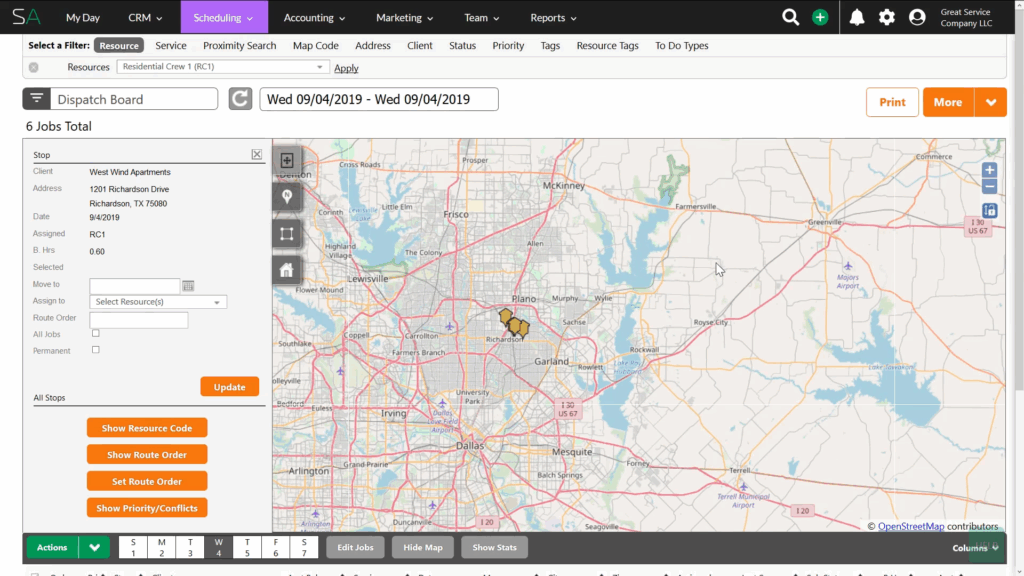
But here’s the catch: This power comes with significant complexity. The user interface feels dense, and distinguishing between different job types and scheduling views (like Dispatch Board, which shows current job assignments and team schedules, vs. Waiting List, which displays unscheduled jobs awaiting assignment) requires dedicated training time. I found myself needing to focus to master these distinctions.
Scheduling is also entirely manager-driven. Unlike more modern platforms like Connecteam, Service Autopilot lacks features like open shifts that employees can claim or automated scheduling based on employee qualifications and availability. There’s no functionality for shift-swapping between employees, either—a feature I’ve found teams love that also reduces administrative burden. The system feels designed for top-down control, which works fine for many businesses but misses opportunities for team flexibility.
Verdict: 8/10
Estimates and client management
Another strength of Service Autopilot is its highly customizable system for creating and managing client estimates before turning them into proposals.
I like how detailed the proposals can be, thanks to the Rate Matrix feature that automates complex pricing rules. For example, you can set up a lawn aeration service that automatically charges a flat rate of $150 for any yard up to 2,000 square feet, and then adds $15 for every 500 square feet over that threshold. For services like mulch installation, you can create a tiered model that automatically applies a lower price per yard as the total quantity increases, effectively building in bulk discounts.

Clients can then review these professional proposals on a dedicated webpage and approve them with their electronic signatures.
Once a proposal is accepted, you can schedule a job with 1 click. All the specific rates and services transfer automatically, which saves significant time. The platform also maintains a comprehensive Activity Stream for each client, logging every interaction from initial estimate to final payment.
Verdict: 7/10
Time tracking
Service Autopilot offers time tracking, but its implementation reveals the platform’s focus: job costing, not employee management. Employees must manually clock in and out of their day, their drive time, and each specific job. While this provides detailed data for analyzing job profitability, it’s cumbersome and prone to human error.

The system lacks automatic time tracking features like geofencing that could clock users out when they leave job sites. This would prevent time theft and ensure accuracy, but Service Autopilot requires all manual entries.
Verdict: 6/10
Invoicing and financials
Service Autopilot’s financial backend is designed to automate billing and streamline accounting. The ability to bulk invoice thousands of clients at once is a massive time-saver for any service business, and the system supports integrated credit card and ACH processing through partner Clearent. Its deepest integration, however, is with QuickBooks.
The platform offers a true, 2-way sync with QuickBooks Online and Desktop, excellent for client data, invoices, and payments, ensuring that billing information remains consistent across both platforms.
However, for this to work, the system is built almost exclusively around QuickBooks. There are no integrations with other popular accounting software like Xero or Sage. So it’s tough for me to recommend Service Autopilot to businesses not already in the QuickBooks ecosystem.
Also, time tracking and payroll data don’t sync with QuickBooks. The system tracks employee hours meticulously for job costing reports, but this information must be manually exported to a separate payroll system.
That said, I think Service Autopilot shines when it comes to automating financial follow-ups. The automation system, available on Pro Plus and Elite plans, works through trigger-based workflows. For example, you can set up a workflow that automatically sends a series of reminder emails to clients with overdue invoices until they pay.
Verdict: 6/10
Service Autopilot Security Features
Service Autopilot has strong infrastructure and payment security, leveraging physically secure data centers, hourly backups, and real-time data replication. It’s PCI-compliant and uses tokenization to protect credit card data, which significantly reduces liability for businesses handling payments.
Internal security is managed through highly granular user roles and rights, giving administrators precise control over what each employee can access. The mobile apps add another modern security layer with support for biometric login via fingerprint or Touch ID.
The main web application lacks multi-factor authentication (MFA), though, relying solely on a basic password policy.
Verdict: 8/10
Service Autopilot Reporting & Analytics
Service Autopilot’s reporting capabilities impressed me with their depth. However, there’s a strong focus on financials as opposed to other important employee-focused reporting like attendance patterns, training compliance, or performance metrics that workforce management tools like Connecteam offer.
The platform offers 2 tiers: pre-built reports for common needs and a custom Report Center for advanced users. The pre-built reports cover essential business areas like profit/loss statements, job costing breakdowns, and sales tracking.
I think the Job Costing Report is great for many types of field service businesses—it compares budgeted versus actual hours and revenue for each visit, helping you spot unprofitable jobs quickly. The Revenue by Service Summary and A/R Aging reports also provide solid financial insights.
When you want deeper analysis, the Report Center lets you build custom reports from scratch. But requires technical knowledge of database logic and SQL-like formulas. It’s very powerful but has a huge learning curve.
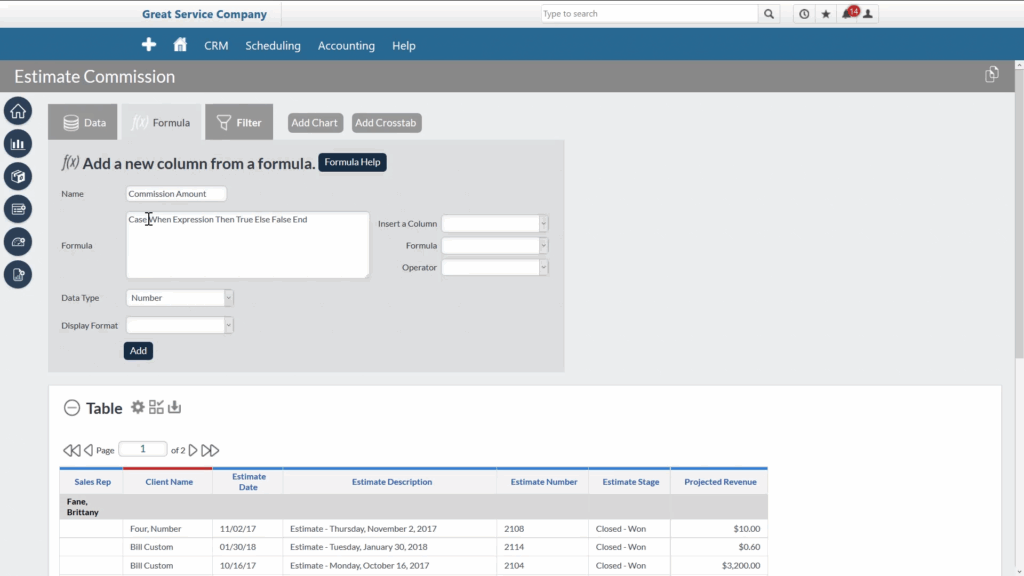
Caption: Service Autopilot offers you a lot of flexibility in how you build your reports, even supporting SQL formulas.
Service Autopilot is primarily a data provider, not an insight generator. The system won’t proactively alert you to declining efficiency or suggest improvements. You can get comprehensive data, but extracting actionable insights requires manual analysis.
Verdict: 6/10
Service Autopilot Customer Support
Before you become a customer, your main option is to sign up for a personalized demo that’s performed via Zoom. Service Autopilot offers several ways to get help once you’re a paying customer: phone, live chat, email ticketing, and a knowledge base. There’s also an “Ask AI” feature that provides quick answers to common questions, though it’s basically just another way to search the knowledge base.
Support hours are Monday–Friday, 8:00 a.m.–5:00 p.m. CST, with limited weekend and holiday coverage for urgent requests. In my experience, phone support is prompt and helpful, though some users have reported being left on hold for long stretches. I got through immediately to a sales representative during working hours, and when I sent an email to support, I received a call on my cellphone within a few hours.
The training resources are extensive, too. Service Autopilot offers demo sessions, virtual group training, one-on-one coaching, and self-paced courses. The knowledge base contains hundreds of articles organized by software modules. This can help with the platform’s learning curve, and if you like watching training videos, Service Autopilot has hundreds for you.
Verdict: 7/10
What Are Service Autopilot’ Review Ratings from Review Sites?
(As of July 2025)
Capterra: 4.1/5
G2: 4.5/5
Software Advice: 4.1/5
TrustRadius: 4.5
GetApp: 4.1/5
Google Play Store: 3.2/5
Apple App Store: 2.7/5
Service Autopilot App Review
Service Autopilot is a high-performance engine for optimizing the financial and operational side of a mature service business. If you live and breathe metrics and want to know your exact profit margin on every job, this is your tool. Its strength is its depth.
But that depth is also its biggest weakness. For businesses outside its core lawn care and cleaning focus, some of its features won’t be useful, and the system will feel overly complex. And for businesses wanting tools for modern team management, you’ll find better, more user-friendly options elsewhere.
Connecteam: The Better Service Autopilot Alternative
Service Autopilot offers a wealth of features for large, established lawn care businesses (and similar companies). If your company doesn’t closely fit that mold, you might consider Connecteam: a more balanced operations platform that’s more versatile and offers more functionality.
For example, Service Autopilot’s scheduling system requires managers to control every assignment manually. Connecteam’s employee scheduler has drag-and-drop scheduling that feels intuitive from day one. You can create shifts in seconds, and employees can claim open shifts that match their qualifications. When changes happen, shift swapping happens through the app with or without your approval (you decide).
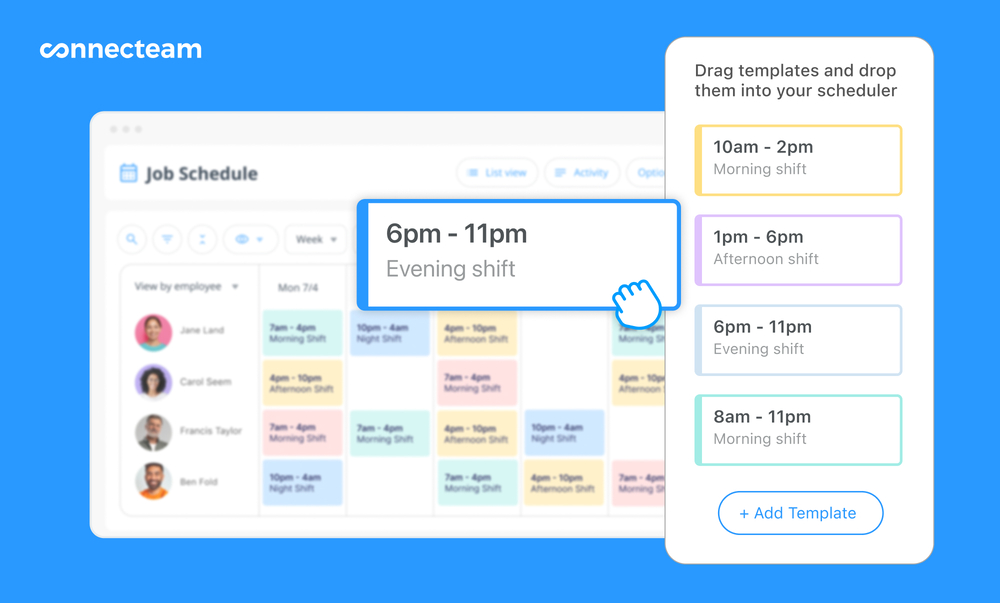
The auto-scheduler goes further by building entire schedules automatically. It considers employee availability, qualifications, and preferences—details that Service Autopilot’s manual system can’t easily account for at scale.
Service Autopilot requires employees to manually log every clock-in, drive time, and break. Connecteam’s employee time clock eliminates this friction with various GPS features: You can automatically verify workers’ locations at clock-in and clock-out, prevent them from tracking time outside job sites, and even track their real-time locations throughout their shifts.
The system compiles everything into payroll-ready timesheets that integrate directly with QuickBooks, Gusto, Xero, Paychex Flex, ADP, and other popular payroll services.
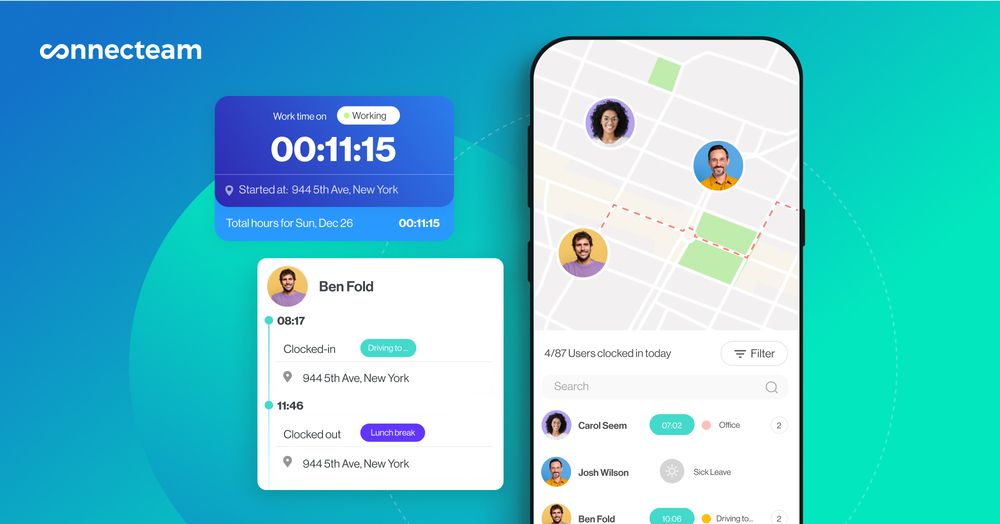
Where Service Autopilot uses a ticket-based messaging system that feels like internal email, Connecteam offers modern online team chat with group messaging, direct chats, and instant file sharing. Teams can send job site photos, coordinate on the fly, and stay connected without switching between apps.
Connecteam also includes workforce development tools that Service Autopilot lacks entirely—an employee training app, a searchable company knowledge base, and employee rewards and recognition programs that help reduce turnover. You can build onboarding courses, track safety training compliance, and gather feedback through employee surveys.
I also appreciate Connecteam’s transparent pricing structure. Small teams get a free plan for up to 10 users, and paid plans start at just $29/month for 30 users. No custom quotes, no mandatory training sessions, and no dual-interface confusion.
FAQs
No, Service Autopilot doesn’t offer a free trial, but you can schedule a 1-hour demonstration over Zoom with a sales representative.
Service Autopilot doesn’t currently meet HIPAA compliance standards. US companies required to handle protected health information should consider HIPAA-compliant alternatives such as Connecteam.
